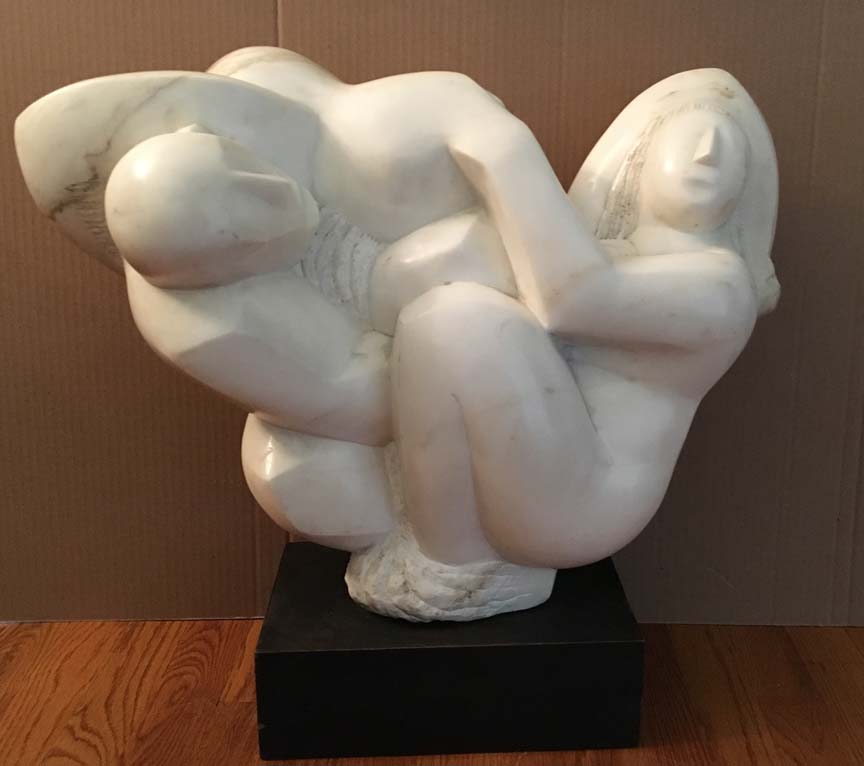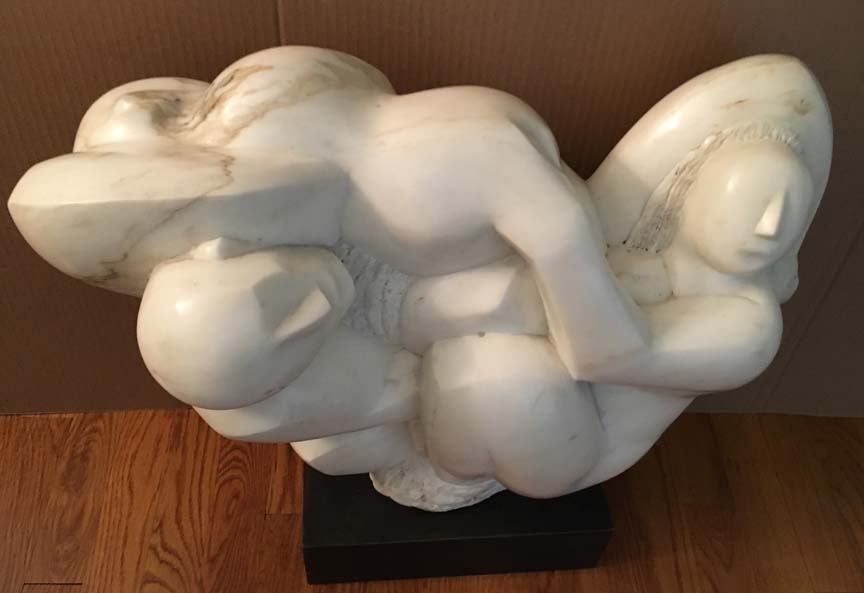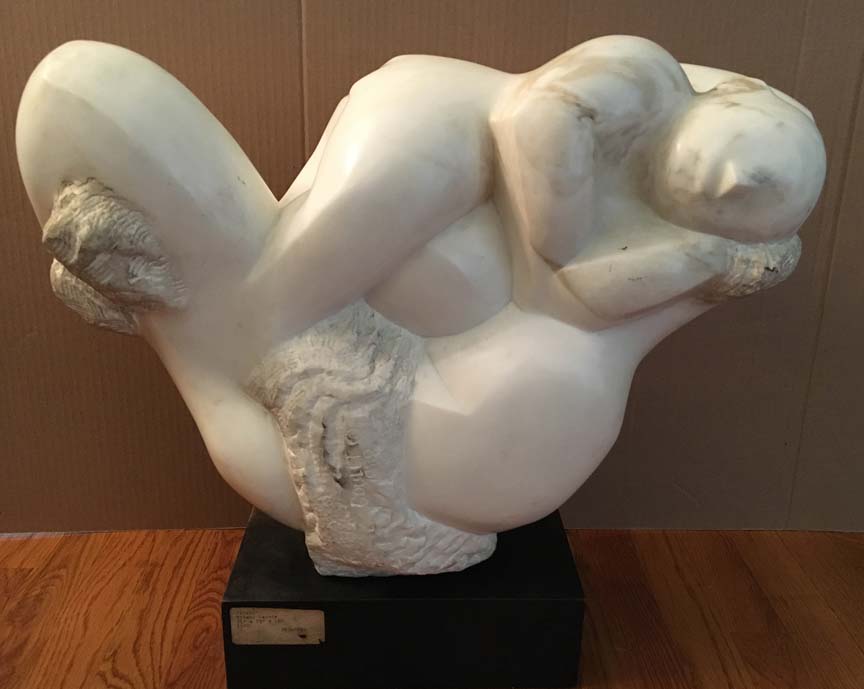

LORRIE GOULET
"AGAPE"
"DIVINE LOVE"
MILANO MARBLE, SIGNED
AMERICAN, DATED 1988
21 X 23 X 10 INCHES


Lorrie Goulet Born 1925 Biography from David Findlay Jr. Gallery By Dena Merriam It is rare to find an artist who can with eloquence articulate the source, inspiration and impulses that feed her or his art form. Creation, being an intuitive process, bypasses the verbal—and often the conceptual—circuitry. Artists create, and it is up to others to fathom their works. Highly gifted stone and wood carver Lorrie Goulet has taken it upon herself to explore what it is about a sculpture that causes the work to have an impact on us and evoke an emotional response: in particular, how the harmonies of, say, a Bach composition can be discovered in a piece of stone; and how, without knowing it, we respond to these symphonic forms. "Sculpting is a conversation without words," says Goulet about the artistic process. "It is a nonverbal communication between the sculptor and the material, and then between the audience and the material. When you listen to a bird, you don't ask what his song is about, but you are moved by its beauty." So it is with sculpture, explains Goulet. Yet there are mathematical equations and relationships in operation in every piece of sculpture that, though we may be unconscious of them, affect the way a work touches us. "The relationship between music and math is more easily recognized," says Goulet. "I didn't see the mathematical relationships in sculpture until I began quadrating my sculpture through overlays and a grid system." Some ten years ago, Goulet began overlaying mathematical constructs on sculpture as a teaching aid, to help her students understand the construction of a head. When she began working on the planes of the head, she was amazed at what she found. "You can actually map out the head," says Goulet. You can navigate and put a head together by constructing the angles. That showed me the relationship between art and the natural world." In sculpture there is an intimate relationship between the seen and the unseen, says Goulet, between the embodied form and the space around it. She points to a line on one of her sculptures, tracing the line out into space beyond the actual stone form. "This line extends outward toward infinity. If you extend this other line, the two will meet our in space and form a triangle—making up the larger construct in which the stone sculpture exists." Composers may not think about mathematical equations when they compose a work, but intuitively they perceive them, and their success depends on their ability to capture the intricate harmonies underlying the structure of the universe that poets, philosophers and mystics have spoken about through the ages. Similarly, a majority of sculptors don't construct their forms using mathematics, but the most gifted artists intuitively tap into the mathematical laws that govern creation: the actual stone, wood, or bronze piece makes visible a small portion of the lines, triangles, and quadrants that exist within that space. The emotional impact of a work is generated by more than just technical prowess: according to Goulet, there is a correspondence between the power of a sculpture and the degree to which it reflects the universal laws. If we could train our eye to see the whole, not just the visible portion, we would find that great works of sculpture exist within a ratio of harmony and a system and a system of numbers as intricate and interwoven as a Bach fugue. The ratio of harmony is the system of numbers that consistently appears in an artist's work. Goulet's correlation of math and sculpture came recently in her evolution as an artist. Her early years were occupied with learning to master the medium of stone and with finding her own voice. It is impossible to track her development without mentioning the man with whom she shared forty-three years of her life, the Spanish-born sculptor José de Creeft. Clearly, de Creeft played a role in shaping the early adult life and work of Lorrie Goulet. But he had less of an influence on her style and aesthetic than one might expect, considering that she met and married the sixty year old sculptor when she was only nineteen. As a young woman coming of age in the shadow of the master carver, Goulet's struggle for independent artistic expression was made all the more difficult, but she was able to muster the will and determination to separate herself artistically from the man she so respected and loved. When Goulet met de Creeft during her student years at Black Mountain College in North Carolina, she had already set in the direction of art, having worked in the medium of sculpture since the age of eight. The young art student was drawn to the teacher, whom she described as "a great, great sculptor" and "a fountain of creative energy." "We were two different artists who shared a life and did our own thing," says Goulet. "It was not a competitive relationship. I worked independently and would invite him to my studio once or twice a year. And then it was just to show him my work, not for any criticism or critique." Over the years Goulet has developed a style and series of themes that are decidedly her own. Relationships, family, love, the earthy undulations of the female form—these are the subjects of Goulet's carvings. Through these themes she strives to convey harmony, serenity, fullness and abundance. Her work is replete with a marvelous feminine energy, where rounded thighs and arms vibrate with a magnetic, yet not quite erotic, rhythm. Whether crouching, reposing, or embracing, her forms are often merging into each other or into the surrounding material, as if to highlight our interconnectedness with each other and the larger universe. Goulet's forms, portray an exuberance, a joie de vivre. There is a rhythm to their often rocking postures that breathes life into the stone. The amalgam of orbs composing Goulet's forms is, like the earth itself, a landscape of mountains and valleys. Their contours suggest fertility, with its accompanying sense of nourishment and wholeness. The Kiss achieves a balance in its motion that suggests the ideal harmony which is the goal of the relationship between a man and woman. It is difficult to discern where the woman's form ends and the man's begins, yet in their joining, they remain apart. The two heads jut out from the forms like twin mountain peeks, each maintaining its own strength and dignity. Goulet's Navajo, although a single figure, portrays a similar sense of wholeness and a combining of forces. In this case, however, it is not the joining of two bodies and souls, it is the quality of self-containment, a gathering of oneself, that is conveyed. It is difficult to determine whether the Native American woman is staring outward or inward, so steady is her gaze. While Goulet's figures contain great emotive power, they also reflect logical and seasoned relationships—the mathematical properties to which she frequently refers. "There are numbers connected to my work as well as emotions," says Goulet. The parts of the body are elements in a composition. The invisible structure underlying the form provides its resonance and power. When Goulet's students ask her what it all means, she tells them to expand their vision to see all points in space where the lines of the figure intersect. Then they will get a sense of the relationship between the seen and unseen. "This is not a new way of seeing the world," says Goulet with a chuckle. "But it's a way of seeing that hasn't been talked about for a long time. In 600 B.C., Pythagoras said God is numbers and the system of the universe is reflected in everything. In the geometry of the structure can be found an expression of the universal spirit. My work is a combination of flesh and geometry. I am concerned with beauty, order and structure. I am seeking to portray these qualities in my sculpture, as well as the feeling of motion and electricity pulsing throughout life."
|